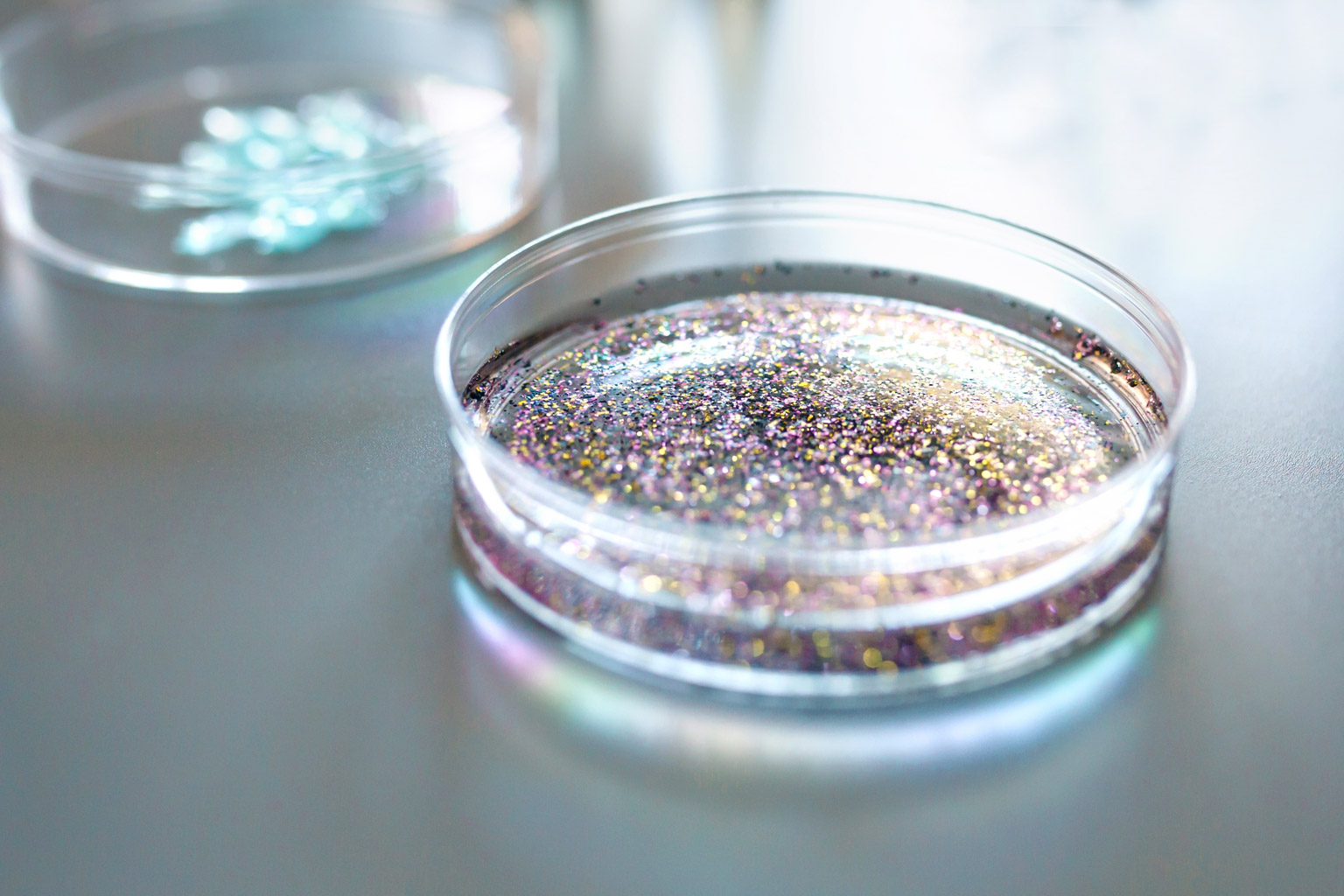Microplastics are generating a lot of concerns and Plastic packaging is as usual pointed at! Is this right? Let’s address this broad topic around two fundamental questions. The first one is about the main sources of microplastics ranked by order of magnitude. The second one is about the position of the FDA and EFSA on the Toxicity of Microplastics. We will not answer here all questions about microplastics but at least set a good base for discussion.

What are the main sources of microplastics ? – Luc Desoutter
What are the main sources of microplastics?
Microplastic pollution (<5 mm) stems from a limited set of well-characterized primary sources. According to IUCN (2017), Earth Action (2023), and Thompson et al. (2024), seven major categories account for the bulk of emissions:
1. Tire Wear from Road Vehicles
Tire abrasion is considered one of the largest global sources of microplastics. As tires degrade through friction with road surfaces, they release synthetic rubber particles that accumulate on roadsides and are transported into soil and waterways via runoff. According to IUCN, tire wear contributes approximately 28% of primary microplastics reaching oceans, and an even higher proportion of land-based emissions. One study estimates that ~500,000 tons/year of tire-derived microplastics are generated in Europe, extrapolated to ~2.5 million tons globally. Tires are thus estimated to account for ~30% of global microplastic leakage.
2. Synthetic Textile Fibers
The laundering of synthetic garments (polyester, nylon, acrylic) releases plastic microfibers into wastewater. These fibers, often too fine to be fully filtered by treatment plants, end up in rivers, oceans, or sewage sludge applied to land. Globally, synthetic textiles are believed to contribute ~35% of primary marine microplastics, and they represent the main source in Asia due to high production and consumption of synthetic clothing. Combined with tire wear, textiles and tires together account for nearly two-thirds of primary microplastic emissions from petroleum-based sources.
3. Paints and Coatings
Paints (e.g., acrylic, epoxy, alkyd) are significant contributors due to the release of paint flakes and polymer dust through weathering and mechanical erosion. This includes road markings, building facades, and marine coatings. Earth Action estimates that paints contribute up to 1.8 million tons/year of microplastics to oceans (~50% of marine primary MPs), and 30–40% of terrestrial emissions. Together with tires and pellets, paints represent one of the three largest global sources of microplastics.
4. Plastic Pellets (“Nurdles”)
These industrial resin pellets (a few millimeters in size) are used as raw materials in plastics manufacturing. Spills occur during production, handling, and transport, releasing pellets into the environment. Though technically mesoplastics in size, their fragmentation and persistence make them a direct source of microplastics. Earth Action estimates ~0.85 Mt/year of pellets reach oceans, and ~3.5 Mt/year are lost on land. Pellet losses represent ~22% of marine and ~40% of terrestrial primary microplastics, making them a top-tier source globally.
5. Cosmetics and Personal Care Products
Microbeads used in exfoliating scrubs, toothpastes, and shower gels once attracted major attention. However, they now contribute a relatively minor share (~1–2%) of global primary microplastic emissions. Regulatory bans (e.g., in the EU and U.S.) on rinse-off cosmetics have significantly reduced this source. Nevertheless, other cosmetic microplastics such as glitter, fibers, or soluble polymers remain in use (e.g., in makeup or creams), contributing several hundred tons annually.
6. Urban Dust and Surface Abrasion
This category encompasses diffuse sources from urban infrastructure, including abrasion of artificial turf, rubber infill, building materials, and the use of microplastics in industrial media (e.g., blasting). Individually minor, these sources collectively contribute to urban dust, which accounted for ~24% of marine microplastic inputs according to IUCN (2017).
Although, concentration of microplastics in city dust varies a lot according to location with a concentration is below 1%, whereas minerals and carboneous materials dominate.
7. Fishing Gear and Marine Debris (Secondary Sources)
While technically secondary, the fragmentation of fishing nets, ropes, and marine litter is a significant source of microplastics in the oceans. These originate as macroplastics but degrade into microplastics through UV exposure, mechanical stress, and biofouling. Though excluded from the 10–40 Mt annual primary microplastics estimate, they explain why concentrations of microplastics continue to rise, even if new emissions were stopped.
Comments:
The primary mechanism of microplastics generation, likewise for dust, is mechanical friction and wear. For textile we should add the structure and size of textile fibers stapple of polyesters (PET fiber grade) that are about 20 microns in diameters and around 3 centimeters in length: this is why under washing condition, a tiny part separates and goes to the drain. The size of cotton fibers is actually very similar to the one of Polyester, since Polyester stapple fiber development was made to replace Cotton that could not face the textile demand. Chemically speaking, cotton is a polymer called cellulose!

Plastic polymer granules © Luc DESOUTTER
2. Positions of the FDA and EFSA on the Toxicity of Microplastics?
Health and food safety agencies have begun addressing the potential risks of microplastics, but their official positions remain cautious due to the lack of conclusive toxicological data. Below is a summary of the current stance of the U.S. Food and Drug Administration (FDA) and the European Food Safety Authority (EFSA):
FDA (United States)
In 2022, the FDA published a statement on micro- and nanoplastics in food, declaring that:
“Current scientific data do not demonstrate that the levels of microplastics found in food pose a risk to human health.” (source: FDA.gov)
In other words, according to the FDA, the estimated exposure through food (e.g., salt, bottled water, seafood) is currently below known thresholds of concern. The agency does not set any quantitative exposure limits for microplastics, citing the absence of sufficient toxicological data to establish a tolerable daily intake (TDI).
Its current approach is one of scientific surveillance: monitoring ongoing research and updating risk assessments should concrete evidence of harm to humans emerge.
The FDA also highlights the lack of standardized methodologies for detecting and quantifying microplastics in food matrices, which hinders reliable risk evaluation.
In its communications, the FDA references studies reporting the presence of microplastics in various food items (table salt, honey, beer, bottled water), and even in human biological samples (blood, urine). However, the agency stresses that: “Presence does not equal risk.”
It also notes that the potential chemical migration from microplastic particles (e.g., bisphenol A, phthalates) into the human body appears negligible compared to other direct sources of such contaminants.
In summary, the FDA concludes that it is too early to declare microplastics a proven food safety hazard, and that no regulatory action (e.g., limits, bans) is currently warranted. However, the agency adheres to a precautionary framework, committing to minimizing exposure to all foodborne contaminants as much as reasonably possible (e.g., through its Closer to Zero initiative).
Regulatory note: The U.S. banned plastic microbeads in rinse-off cosmetics in 2015, not due to demonstrated toxicity to humans, but to mitigate environmental impact.
EFSA (Europe)
EFSA addressed the issue as early as 2016, publishing a scientific opinion through its CONTAM Panel. In this report, EFSA concluded that: “Based on current concentrations, microplastics in food—particularly seafood—are unlikely to pose a health risk to consumers.” (source: EFSA, 2016)
This conclusion was based on “worst-case scenario” exposure modeling, for example assuming the ingestion of a portion of mussels containing up to 900 microparticles. Even in this extreme case, the chemical exposure (e.g., to bisphenol A or PCBs potentially released from plastic particles) was considered well below existing toxicological thresholds.
However, EFSA noted significant data gaps and uncertainties, especially concerning nanoplastics (<1 µm), which may cross intestinal barriers and potentially reach internal organs.
EFSA’s key message:
“It is too early to affirm that microplastics represent a food safety risk, but at current levels, this seems unlikely—particularly for particles >150 µm.”
The agency called for further research on:
- The occurrence of particles <150 µm in food,
- Their behavior in the gastrointestinal tract,
- Their potential toxicity (e.g., effects on the microbiome, local inflammation).
EFSA also emphasized the urgent need for standardized analytical methods for detecting and quantifying microplastics in food matrices.
In 2021, EFSA organized a scientific colloquium on micro/nanoplastics, confirming that this remains an emerging area of concern with insufficient data to conduct a full risk assessment.
To date (2024), EFSA has not established any regulatory exposure thresholds or TDI for microplastics. Its position follows the ALARA principle (“As Low As Reasonably Achievable”): given the uncertainties, it is recommended to minimize plastic emissions to the environment to reduce potential exposure, even in the absence of confirmed adverse effects.
EFSA’s reports reference several notable studies, such as:
- Thompson et al. (2013): detection of microplastics in 184 fish from the English Channel.
- In vitro studies showing cytotoxicity of microplastics on cultured human cells.
Still, EFSA concludes that:
“There is currently no firm evidence that consumption of seafood contaminated with microplastics poses a human health risk.”
Since 2016, EFSA has not published a comprehensive toxicological reassessment, but the European Chemicals Agency (ECHA) has proposed restrictions on the intentional use of microplastics in commercial products to reduce environmental release.
Exposure Limits and Toxicological Benchmarks
As of 2024:
- Neither FDA nor EFSA has defined specific numerical exposure limits (TDI or RfD) for microplastics.
- Both agencies refer to existing toxicological benchmarks for chemical additives (e.g., bisphenol A, phthalates), noting that the contribution from microplastics is currently considered marginal.
They also acknowledge a lack of understanding of:
- Long-term effects, especially from chronic low-level exposure,
- Possible immune or endocrine disruption from plastic particles or additives,
- The toxicokinetics of nanoplastics (e.g., absorption, accumulation, placental transfer).
For example, the FDA has noted that in vitro studies have shown cell damage at high concentrations of microplastics, but the in vivo relevance to human health remains unclear.
Conclusion: Scientific Vigilance Without Alarmism
Both FDA and EFSA maintain a position of scientific vigilance and caution. They recognize the ubiquity of microplastics in the environment—and increasingly, in the human body—but stress that current documented exposure levels do not yet justify regulatory concern.
Their stance is consistent:
- Monitor research continuously,
- Address data gaps (particularly for nanoplastics and sensitive populations such as pregnant individuals),
- Advocate upstream pollution reduction, rather than quantitative exposure limits (for now).
As science progresses—e.g., through epidemiological studies linking microplastic body burden to disease outcomes or through established No-Observed-Adverse-Effect Levels (NOAELs) in animal models—both agencies may revise their evaluations. But for now, the message remains:
“Emerging concern—not panic. Monitor, research, and prepare.”


